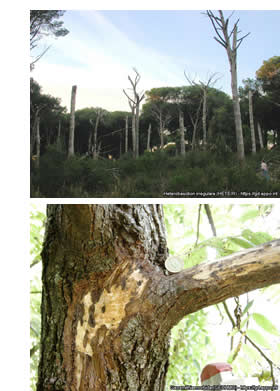
51st meeting of the Panel on Phytosanitary Measures
Paris, 2015-03-11/13
The Panel met in Paris in the EPPO headquarters on 2015-03-11/13. The main task of this Panel is to evaluate risks presented by specific pests and design phytosanitary measures to avoid their introduction and spread. The first day was a joint meeting with the Panel on Quarantine Pests for Forestry to discuss common issues.
EPPO lists of pests recommended for regulation
 On a case by case basis, the Panel reviewed in detail PRAs prepared by the Expert Working Groups for PRA and performed pest risk management when necessary, and it also reviewed national PRAs. The Panel recommended to the Working Party the addition to the A2 List of Geosmithia morbida and Pityophthorus juglandis, and Heterobasidion irregulare.
On a case by case basis, the Panel reviewed in detail PRAs prepared by the Expert Working Groups for PRA and performed pest risk management when necessary, and it also reviewed national PRAs. The Panel recommended to the Working Party the addition to the A2 List of Geosmithia morbida and Pityophthorus juglandis, and Heterobasidion irregulare.
Both Panels discussed how guidance could be developed to establish Pest Free Areas for bark beetles in general and Polygraphus proximus in particular.
The Panel reviewed the present situation of A1 pests and considered that Dacus ciliatus and Bactrocera zonata should be transferred from the A1 to the A2 List. The situation of Anthonomus eugenii and Anoplophora glabripennis should be reviewed next year.
Alert List
The Panel reviewed the EPPO Alert List (the purpose of this List is to warn countries about possible new risks, and in certain cases to propose candidates for PRA and eventually regulation). Considering that the alert had been given and that no further action was needed, the Panel decided to delete Aproceros leucopoda, Thaumastocoris peregrinus, Hederodera zeae, Punctodera chalcoensis. The Panel suggested some emerging pests that could be added to the Alert List (e.g. Massicus raddedi, Sirococcus tsugae, Botryosphaeria juglandis, Zaprionus indianus).
Guidelines to establish pest lists in pathway studies
As agreed at the previous meeting, a first draft of a general Standard has been developed to provide guidelines to establish pest lists in pathway studies. This Standard is based on the procedures developed for the Tomato study and DROPSA. Development will carry on at the next meeting.
Pest Risk Analysis
The Panel had a brainstorming session together with the Panel on Quarantine Pests for Forestry on “Pest Risk: from early warning to pest management”.
The Panel finalized the document describing the different circumstances for use of PRA, their purpose and audience, the schemes used and the time and resources needed to complete them. A questionnaire will be sent to NPPOs to clarify which schemes are used in EPPO countries and the level of detail needed in different PRAs.
In addition to the review of PRAs (see above) the Panel established the priorities for the organization of EWGs for PRA. The selection was made taking into account the following elements: geographical distribution, importance of the crop(s) concerned, risk of natural spread into the region or for further spread within the region, potential pathways, economic impact, environmental impact, possibilities of control, similarities to other known cases, availability and validity of data. The Panel agreed that Lycorma delicatula, Pseudacysta perseae and Meloidogyne mali were the highest priorities for PRA. This will be further discussed by the Working Party. The Panel will also review a number of national PRAs or EFSA opinions (e.g. Strauzia longipennis, Platynota stultana Euwallacea fornicatus and Fusarium euwallaceae, Xylosandrus crassiusculus, solanaceous pospiviroids, Pomacea maculata and P. canaliculata) to recommend pests for regulation.
Contingency plan
The Panel agreed that an expert working group should be organized to develop a contingency plan for Popillia japonica.
Guidance on the phytosanitary measure ‘plants grown under complete physical isolation’
The Panel finalized the draft guidance on the phytosanitary measure ‘plants grown under complete physical isolation’.
Tomato study
In the EPPO Study on pest risks associated with the import of tomato fruit, a number of pests that may be associated with tomato fruit and may present a risk for the EPPO region have been identified and documented. A scoring system was developed and tested to select the pests for which specific requirements are likely to be needed in addition to the PC requirement. The Panel agreed that further work should be done on the following pests: Ceratothripoides brunneus, Bactrocera latifrons, Aleurotrachelus trachoides and Prodiplosis longifila.
Update on DROPSA
An update on the progress made on the EU FP7 project DROPSA was presented including the list of priority fruits for pathway studies. An article was published in the EPPO Bulletin. The final objective of the project is to prepare alert lists identifying pests likely to be found on selected fruit species.
The next Panel meeting is planned 2015-10-06/08 in Bologna (IT).
